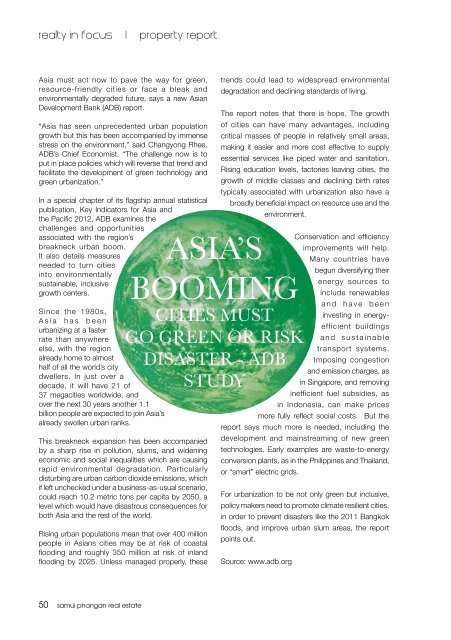Samui Phangan Real Estate Magazine October-November
Samui Phangan Real Estate Magazine Edition: October-November-2012 The definitive Guide to Samui Phangan Real Estate http://www.samui-phanganmagazine.com/
Samui Phangan Real Estate Magazine Edition: October-November-2012
The definitive Guide to Samui Phangan Real Estate
http://www.samui-phanganmagazine.com/
You also want an ePaper? Increase the reach of your titles
YUMPU automatically turns print PDFs into web optimized ePapers that Google loves.
ealty in focus l property report<br />
Asia must act now to pave the way for green,<br />
resource-friendly cities or face a bleak and<br />
environmentally degraded future, says a new Asian<br />
Development Bank (ADB) report.<br />
“Asia has seen unprecedented urban population<br />
growth but this has been accompanied by immense<br />
stress on the environment,” said Changyong Rhee,<br />
ADB’s Chief Economist. “The challenge now is to<br />
put in place policies which will reverse that trend and<br />
facilitate the development of green technology and<br />
green urbanization.”<br />
In a special chapter of its flagship annual statistical<br />
publication, Key Indicators for Asia and<br />
the Pacific 2012, ADB examines the<br />
challenges and opportunities<br />
associated with the region’s<br />
breakneck urban boom.<br />
It also details measures<br />
needed to turn cities<br />
into environmentally<br />
sustainable, inclusive<br />
growth centers.<br />
Since the 1980s,<br />
Asia has been<br />
urbanizing at a faster<br />
rate than anywhere<br />
else, with the region<br />
already home to almost<br />
half of all the world’s city<br />
dwellers. In just over a<br />
decade, it will have 21 of<br />
37 megacities worldwide, and<br />
over the next 30 years another 1.1<br />
billion people are expected to join Asia’s<br />
already swollen urban ranks.<br />
This breakneck expansion has been accompanied<br />
by a sharp rise in pollution, slums, and widening<br />
economic and social inequalities which are causing<br />
rapid environmental degradation. Particularly<br />
disturbing are urban carbon dioxide emissions, which<br />
if left unchecked under a business-as-usual scenario,<br />
could reach 10.2 metric tons per capita by 2050, a<br />
level which would have disastrous consequences for<br />
both Asia and the rest of the world.<br />
Rising urban populations mean that over 400 million<br />
people in Asians cities may be at risk of coastal<br />
flooding and roughly 350 million at risk of inland<br />
flooding by 2025. Unless managed properly, these<br />
50 samui phangan real estate<br />
trends could lead to widespread environmental<br />
degradation and declining standards of living.<br />
The report notes that there is hope. The growth<br />
of cities can have many advantages, including<br />
critical masses of people in relatively small areas,<br />
making it easier and more cost effective to supply<br />
essential services like piped water and sanitation.<br />
Rising education levels, factories leaving cities, the<br />
growth of middle classes and declining birth rates<br />
typically associated with urbanization also have a<br />
broadly beneficial impact on resource use and the<br />
environment.<br />
ASIA’S<br />
BOOMING<br />
CITIES MUST<br />
GO GREEN OR RISK<br />
DISASTER - ADB<br />
STUDY<br />
Conservation and efficiency<br />
improvements will help.<br />
Many countries have<br />
begun diversifying their<br />
energy sources to<br />
include renewables<br />
and have been<br />
investing in energyefficient<br />
buildings<br />
and sustainable<br />
transport systems.<br />
Imposing congestion<br />
and emission charges, as<br />
in Singapore, and removing<br />
inefficient fuel subsidies, as<br />
in Indonesia, can make prices<br />
more fully reflect social costs. But the<br />
report says much more is needed, including the<br />
development and mainstreaming of new green<br />
technologies. Early examples are waste-to-energy<br />
conversion plants, as in the Philippines and Thailand,<br />
or “smart” electric grids.<br />
For urbanization to be not only green but inclusive,<br />
policy makers need to promote climate resilient cities,<br />
in order to prevent disasters like the 2011 Bangkok<br />
floods, and improve urban slum areas, the report<br />
points out.<br />
Source: www.adb.org





